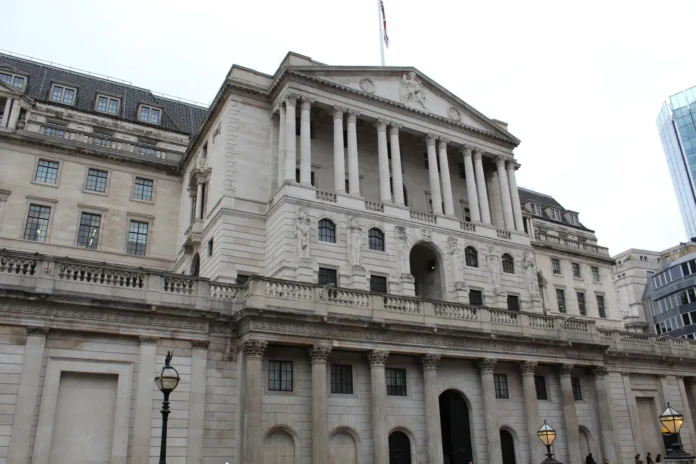The Bank of England has reduced the Bank Rate by 25 basis points to 4.25% in a closely contested decision that revealed diverging views on the strength of inflationary pressures and the resilience of the UK economy.
The nine-member Monetary Policy Committee voted 5–4 in favour of the cut, with two members pushing for a deeper 50 basis point reduction, and two others preferring to keep the rate unchanged at 4.5%.
The majority of the Committee agreed that a modest reduction in Bank Rate was now justified by continued progress on disinflation, a loosening labour market and subdued underlying GDP growth. Inflation eased to 2.6% in March, close to the Bank’s forecast, and is expected to fall back towards the 2% target in the medium term, despite a temporary rebound to 3.5% in the third quarter driven by energy prices and regulated bills.
TARIFFS AND TRADE TENSIONS
Governor Andrew Bailey was among the five members voting for the 0.25 percentage point cut. According to the minutes, some of those in this group viewed the decision as marginal prior to recent global developments, but were swayed by the economic implications of rising trade tensions following new US tariffs and retaliatory measures from key trading partners.
The Bank said that while the impact on UK inflation from these developments was ambiguous, the broader risks to global growth were clearly tilted to the downside.
Two members, Swati Dhingra and Alan Taylor, called for a more aggressive 0.5 percentage point cut, citing the risk that a persistently restrictive stance could open up a larger-than-necessary output gap.
They argued that the expected increase in inflation this summer would be driven mainly by one-off factors rather than sustained price pressures, and noted that private sector wage settlements were approaching levels consistent with the Bank’s inflation target.
By contrast, Catherine Mann and Huw Pill preferred to leave Bank Rate unchanged. They pointed to continued resilience in the labour market, signs of persistent domestic inflation pressures, and a recent firming in household inflation expectations.
For them, maintaining the current level of restrictiveness would help ensure inflation returns to target without undue delay.
CAUTIOUS PATH
The committee reiterated that monetary policy was not on a pre-set path, and signalled that any further easing would be pursued cautiously. “A gradual and careful approach to the further withdrawal of monetary policy restraint remains appropriate,” the summary stated, underscoring a commitment to hold rates in restrictive territory until risks to the inflation outlook have dissipated further.
UNDERWHELMING

Paul Noble, chief executive of Chetwood Bank, said: “Following a second consecutive fall in inflation, many were expecting a bolder move from the Bank of England.
“The decision to cut rates by 0.25% rather than half a percentage point might appear underwhelming to some, given the challenges that are being faced – especially the uncertainty around Trump’s tariff hikes.
“Today’s move could risk underutilising a vital opportunity to restore confidence and stimulate growth in the market.”
“While the central bank has taken a cautious approach for some time, today’s move could risk underutilising a vital opportunity to restore confidence and stimulate growth in the market.
“That will come from the MPC making bold, market-altering decisions at its monthly meetings, rather than smaller, potentially less impactful changes that fail to make the most of our current inflationary improvements.
“For savers, the rates available today may be the most competitive we’ll see for some time, so it’s important they take steps to protect their financial position. A quick review of your savings could help ensure your money continues to deliver value, and that you’re not missing out on the strongest rates while they last.”
CAUTION EXPECTED
Martin Temple, Economist at Leeds Building Society, said: “The reduction in the base rate by 0.25% to 4.25% will be welcome news for those currently on a tracker mortgage product but won’t have a direct impact on other mortgage rates, as market pricing has already adjusted on the assumption that this would happen.
“Until there is greater clarity over how the UK economy is performing, including the potential persistence of inflation, we continue to expect members of the monetary policy committee to act in a cautious manner with respect to future decisions on interest rates.
“This was borne out by the split vote today – whilst the majority voted for a 0.25% reduction, two members voted to hold rates at 4.50% and another two voted for a larger, 0.50%, reduction. Markets currently expect bank base rate to be reduced by another 0.25% in August and again in November.”
LENDER PRICE WAR

Tony Hall, head of business development at Saffron for intermediaries, said: “The recent price war among lenders was a clear indication that many had already factored in a potential base rate cut, so today’s news doesn’t come as a huge surprise.
“While rates will always fluctuate, we’re seeing more competitively priced deals across the board, including sub-4%, which is encouraging for buyers of all types and deposit sizes.
“Looking ahead, there’s growing confidence in the market that fixed rates will continue to come down throughout the rest of the year.
“This comes as the FCA launches a new consultation this week, aimed at making it cheaper for borrowers to switch or change their mortgage. With proposals already in the works to ease current stress-testing rules, it’s clear that regulators are also moving to improve affordability in the market, all of which is good news for potential buyers.”
PIVOTAL MOMENT

Steve Cox, chief commercial officer at Fleet Mortgages, said: “The Bank of England’s decision to cut Bank Base Rate today marks a further pivotal moment for the mortgage market and comes off the back of a steady downward trend in swap rates over recent months.
“We’ve already seen this reflected in product pricing, with Fleet ourselves having made a number of reductions to our buy-to-let product rates recently.
“For lenders and advisers operating in the buy-to-let sector this provides a welcome boost.”
“For lenders and advisers operating in the buy-to-let sector, this provides a welcome boost – a clearer signal that affordability continues to improve, giving more landlord borrowers the opportunity to secure the funding they need.
“Of course, we can never be absolutely certain of the long-term direction of travel, but the recent trend does suggest rates will continue to edge downwards, which will only strengthen landlord confidence.”
SLOWING ECONOMIC GROWTH

Colin Bell, chief operating officer at Perenna, said: “Today’s rate cut is a reflection of the UK’s slowing economic growth – despite the broader, global economic uncertainties, the need to stimulate spending at home is clearly the priority for the MPC.
“This will undoubtedly be positive news for many home buyers and those looking to remortgage, offering some relief and creating some demand in the short-term.
“But for many aspiring homeowners, the impact will be limited – the latest research from the Adam Smith Institute highlights the stark reality for English renters who work 125 days a year just to pay their landlords leaving them struggling to save for a deposit.
“Even those who do have a sizeable deposit remain locked out of traditional mortgage options thanks to stringent affordability rules.
“If policymakers are serious about addressing the housing crisis, they must go beyond rate cuts and tackle the structural barriers to homeownership.”
TARIFF FALLOUT

Ryan Etchells, chief commercial officer at Together, said: “The fallout from US President Donald Trump’s policy on tariffs has caused a huge amount of instability, leading to economists predicting a slowing global economy.
“To combat the likelihood of US policy depressing the UK economy, the Bank of England’s has decided to cut its base rate by 0.25% to 4.25%, lowering the cost of borrowing for individuals and businesses, which will provide a much-needed boost to the UK property market.
“It will mean those who were facing steep monthly mortgage payments will now be able to access lower rates, allowing more home buyers who would previously have been priced out of the market to achieve their property ambitions.”
BANK PLAYING CATCH-UP

Martyn Smith, chief executive officer at Black & White Bridging, said: “While today’s rate cut is a step in the right direction, it feels like the Bank of England is still playing catch-up. Inflation is falling, economic growth is anaemic, and borrowers have been shouldering high interest rates for too long.
“A sharper cut would have made a clearer statement and brought quicker relief to households and businesses alike.
“In the bridging space, we expect to see an uptick in enquiries as borrowing costs edge down and confidence returns. But lenders and borrowers alike are still waiting for decisive momentum – something a larger cut might have delivered.
“In the buy-to-let sector, this move will have a more meaningful psychological than material impact. Many landlords are looking for signs of stability and direction, and today’s decision gives them hope that the worst is behind us. That said, swap rates have already priced in a degree of optimism, and some in the market may see this decision as too little, too late.
“The Bank must now show leadership, not just caution. Following market sentiment is not the same as setting the agenda – and right now, decisive leadership is what the property market needs.”
FURTHER RATE CUTS

Alan Davison, chief commercial officer of Afin Bank, added: “Today’s Base Rate cut was never in doubt as the economy desperately needs a boost, but I’m not sure it will immediately trigger an increase in mortgage demand.
“Nationwide reported a 0.6% drop in house price growth in April, following a jump in transactions in March as buyers rushed to beat the stamp duty changes. Whether that recovers in the coming months depends on consumer confidence, which is thin on the ground.
“Growth predictions for the UK economy have been cut, while inflation is expected to rise again, leading to higher prices and further pressure on household finances.
“So the big question is could we see further rates cuts from the Bank of England, which could cause borrowers to hold fire on their mortgage plans until interest rates have stabilised.”
NOT TRANSFORMATIONAL

Simon Webb, managing director of capital markets and finance at LiveMore, said: “While this move may not immediately transform mortgage rates, today’s rate cut will provide relief to many borrowers, especially those coming to the end of fixed-rate deals or navigating affordability challenges in a high-cost environment.
“For older borrowers, many of whom are on fixed incomes, a reduction in rates can be crucial in easing monthly payments or improving affordability assessments.
“It’s important that we continue to see innovation and competition in the later life lending space, so that more people aged 50 and over can access the finance they need without being unfairly penalised by outdated criteria or economic headwinds.”
TRADE TENSIONS

Adam Ruddle, chief investment officer at LV=, said: “The Bank of England cutting interest rates to 4.25% was widely expected, reflecting moderating inflation and a slowing economy amidst trade tensions.
“Encouragingly, this reduction could signal a series of rate cuts, with interest rates anticipated to fall to 3.5% by year-end. This is very dependent on the path of US trade policies and any trade agreements agreed.
“Homeowners and prospective buyers will likely breathe a sigh of relief, as lower interest rates may lead to reduced mortgage rates. However, savers may see diminished returns on their deposits. According to LV’s Wealth and Wellbeing research, just under one in five (18%) are concerned about their savings being devalued by low interest rates and inflation.
“Despite these concerns from savers, further cuts are expected. LV’s research shows more than two in five (41%) of mortgage holders are worrying about rising day to day costs, and lower rates could provide much needed relief for consumers.
“A reduction in interest rates may be a welcomed boost for the economy. Borrowing will become more affordable, thereby encouraging spending and investment.”
SWAP RATE IMPACT

Richard Pike, chief sales and marketing officer at Phoebus Software, said: “The Bank of England’s decision to cut the base rate is not unexpected and reflects growing concerns around slower economic growth and trying to ease inflationary pressures.
“For the mortgage market, the big question is how this move affects swap rates, which had already been trending down in anticipation of today’s announcement.
“If we see sustained downward movement in swaps, lenders may begin pricing more competitively in the coming weeks, particularly in the fixed-rate space.
“However, geopolitical factors such as the recent announcement of US tariffs by Donald Trump have injected volatility into global markets and inflation forecasts, which in turn could limit how far UK rates fall in the medium term.
“The industry will need to remain agile in response to both monetary policy shifts and wider economic turbulence.”
TARIFF THREATS

Rob Clifford, Chief Executive of Stonebridge, added: This rate cut is the clearest sign yet that the Bank of England fears serious economic fallout from Donald Trump’s tariff threats – and is acting decisively to shore up the economy.
“After being accused of acting too slowly on inflation, the Bank is clearly aware that it can’t afford to fall behind the curve again, which is why it is taking pre-emptive action now.
“Much of the UK’s current price pressure is imported, not home-grown, which gives the Bank the space to cut rates without reigniting inflation.”
“While some market watchers remain concerned about inflation, we believe those fears are often overplayed. Much of the UK’s current price pressure is imported, not home-grown, which gives the Bank the space to cut rates without reigniting inflation.
“This won’t be the last move we see. We expect at least two more cuts this year – especially if Trump follows through with his most extreme tariff plans.
“Today’s cut will be welcome news for borrowers, as mortgage rates should fall noticeably by the summer. But it also presents a dilemma for them today: fix now or opt for a tracker in the hope of further cuts?
“In moments like these, mortgage advisers have a real opportunity to step up as trusted experts. It’s not just about finding the most competitive deal today — it’s about providing ongoing guidance, navigating uncertainty, and being ready to act when the market shifts again. That’s the kind of long-term value customers will truly remember.”
STIMULATE DEMAND

John Phillips, chief executive of Just Mortgages and Spicerhaart, said: “Today’s decision was clearly not a surprise, with financial markets pricing in a cut with unanimous certainty.
“What will be interesting though is what happens next and whether today’s call is the opening of the flood gates for further and more frequent cuts – with some predicting three or even four more cuts in 2025.
“While there’s no question that President Trump’s trade war has forced the central bank to act with some urgency, so have fears around inflation and both business and consumer confidence – particularly in response to higher taxes and costs.
“Either way, movement on the base rate is absolutely welcomed and will certainly help to stimulate demand. Given the certainty around today’s news, we’ve already seen swaps respond positively and lenders re-price, with the competition for market share likely only to increase with future moves.
“If not already, now is the time for brokers to mobilise – to get out into their local area to share this update. It’s so easy to get bogged down by the news right now, when in fact we can share something really positive with the many who have the appetite to buy, but need help navigating the market.”
CONFIDENCE BOOSTER

Kevin Roberts, managing director of L&G’s Mortgage Services, said: “Today’s decision to cut the base rate by 0.25% will be very welcome news for many homeowners and prospective homebuyers, and this will likely boost confidence in an already buoyant market.
“If you are looking to buy, or remortgage, now is a great time to consult with a mortgage broker to take advantage of this opportunity.
“We’ve already seen many lenders reduce their rates, and competition between providers will bring more tailored products to the market.
“We know the demand is there – our broker mortgage search data shows first-time buyer and remortgaging activity jumped 45% and 34% respectively since last year.”
FAVOURABLE RATE OUTLOOK

Ben Thompson, deputy chief executive at Mortgage Advice Bureau, said: “Despite inflation being likely to tick up again in the near term, the focus has now flipped to ensuring economic growth.
“Markets have been quick to price in future rate cuts, and consequently, it’s great to see so many mortgages now priced below 4%.
“We now have real wage growth, lower mortgage rates, and a favourable rate outlook, plus a record high number of mortgage products overall. We’re even seeing some helpful lending for first time buyers, and hopefully that continues to grow, enabling more renters to become homeowners.
“Notwithstanding what has recently become ‘predictable unpredictability’ globally, it feels as though we have a small tailwind for the first time in a long time (at least domestically). It does now feel like a good time to buy, and a better time to refinance for those that need to.
“For customers looking to get mortgage ready, now is a great time to take advantage of the market. With the expertise and guidance of a broker, you can secure a deal that works for you and your financial circumstances.”
GOOD NEWS FOR BORROWERS

David Hollingworth, associate director at L&C Mortgages, said: “There’s no surprise to see the base rate cut by 0.25% today, bringing it back to a level not seen since March 2023 when rates were climbing toward the recent peak of 5.25%.
“However, the decision was split three ways with two members calling for a deeper cut and two preferring to see the base rate maintained at 4.50%.
“A cut is good news for borrowers but that split highlights the level of uncertainty that remains. A gradual fall in base rate throughout this year was already expected but the recent turmoil in global markets has accelerated the forecast for those cuts.
“That has already resulted in cuts to fixed mortgage rates feeding through for borrowers. The lowest two- and five-year fixed rates are pretty much on par and sit comfortably below 4% now, a marked improvement on where rates sat only a matter of weeks ago.
“Today’s cut will already be priced in and although we’d hope to see lenders continue to make improvements the base rate fall won’t necessarily result in major cuts.”
GREEN LIGHT FOR LENDERS

Matt Harrison, Commercial Director at Finova Broker, said: “Today’s modest 0.25% cut is a welcome first step, but it feels more like the Bank is dipping its toe in rather than making waves.
“For brokers and mortgage clubs this move won’t dramatically shift the market – but it does give lenders the green light to start refining product strategies.
“Brokers will likely see a gradual increase in client confidence, particularly among first-time buyers and remortgagers who’ve been waiting for signs of movement. Lenders may begin adjusting criteria and pricing, which means sourcing platforms and tech tools that can track and compare rapid market shifts will be critical.
“For mortgage clubs, this is an opportunity to support members by curating product updates, sharing lender insight, and helping advisers guide clients through an uncertain but improving rate environment.
“While not a game-changer, this rate cut could be the start of a broader shift—and now is the time for brokers to get ahead of the curve.”
RIPPLE EFFECT

Sharon Beedham, Relationship Director at ONP Solicitors, said: “Even a modest 0.25% cut can have a ripple effect, especially in a market as sentiment-driven as property.
“Buyers and homeowners alike have been looking for signs that affordability is improving — and a small base rate reduction, even if largely symbolic, could be just enough to restore some consumer confidence.
“For those conveyancers who saw intense activity leading up to March’s stamp duty deadline, this could be the catalyst that helps smooth what might otherwise have been a prolonged lull.
“We may not see an overnight spike in completions, but this kind of incremental shift could encourage more remortgaging activity and keep the sales pipeline ticking over. From a sector perspective, it’s about interpreting market signals and being ready to respond to renewed buyer intent, however subtle.”
POSITIVE STEP FORWARD

Sam Lindsay, mortgage and protection adviser at My Mortgage Angel, said: “Although today’s rate drop won’t change much from a lending perspective as many lenders have already factored this into their pricing, it is a huge step in the right direction and will welcome news to both aspiring homeowners and those coming to the end of their existing mortgage terms.
“Getting to sub 4% is ultimately what everyone has been hoping for and so this is going to greatly improve the sentiment in the market and make the dream of home ownership achievable for more individuals.
“While inflation figures and global uncertainty are still creating some nervousness, today’s announcement is a positive step forwards as we look to create a more sustained move towards lower mortgage rates for all.”
RATES ARE STILL HIGH

Luther Yeates, head of mortgages at Orton Financial, said: “Forr many borrowers, it won’t feel like much has changed. When it comes down to it, rates are still high, and that’s keeping borrowing costs up.
“Understandably, many high net worth individuals are looking beyond the UK as they feel the economy is losing momentum and no longer working in their favour.
“Persistently high interest rates, uncertainty around future cuts, and a lack of bold action from the Bank of England all add to that feeling. A bigger rate cut may help restore confidence, encourage investment, and support a stronger recovery.
“The Bank is meant to be leading the economy, not trailing behind it like an anchor.”
“In commercial lending, which tends to follow the base rate more closely, businesses are still finding it difficult to borrow. This is leading to weaker wage growth and fewer new jobs. These all feed into bleak economic forecasts for the UK, as the high interest rates are reflective of the ‘risk’ of recession and economic downturn.
“Right now, the Bank looks like it’s following the economy rather than leading it. It’s meant to be leading the economy, not trailing behind it like an anchor. The European Central Bank has been more decisive, and the UK should do the same.”





